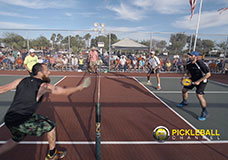What do you do when your opponent starts blasting balls at you and you’re stuck playing defense, barely keeping your head above water? There’s actually a way you can take those hard hit balls and slow them down, making your opponent play your game. Hear from 5.0 player Scott Moore as he talks about a helpful strategy he uses to slow the ball down and reset the point. In this episode of Pickleball 411, Scott lays out why this technique is helpful, how to do it, and even gives a drill to practice this skill with your partner. This is a great, quick video that can make a difference in your pickleball strategy.
========= WATCH THIS RELATED VIDEO =========
 Would you like to see Scott Moore in action? Watch 5.0 doubles players Scott Moore and Wesley Gabrielsen as they challenge Brian Ashworth and Kyle Yates for the gold medal at the Grand Canyon State Games earlier this year. These two teams are both out-of-this-world good and neither lets up on the gas as they play a passionate gold medal match, culminating in a tie-breaker game you’ve got to watch! You don’t want to miss this display of skill, determination and power from all four players in the 5.0 Men’s Doubles Gold Medal Match.
Would you like to see Scott Moore in action? Watch 5.0 doubles players Scott Moore and Wesley Gabrielsen as they challenge Brian Ashworth and Kyle Yates for the gold medal at the Grand Canyon State Games earlier this year. These two teams are both out-of-this-world good and neither lets up on the gas as they play a passionate gold medal match, culminating in a tie-breaker game you’ve got to watch! You don’t want to miss this display of skill, determination and power from all four players in the 5.0 Men’s Doubles Gold Medal Match.
You can click on the SUBSCRIBE HERE button to subscribe for free and be notified as soon as new pickleball videos are released.
Pickleball Channel is powered by the wonderful support of our friends and partners, Hyland’s Leg Cramps. You can also learn more about our partners at hylands.com/products/hylands-leg-cramps
Stay here to watch more #pickleballvideos #pickleball
How should the defender hold his/her paddle when in ready position when the opponent is blasting fast balls at close quarters? I have been told to keep the paddle in the “backhand” position (paddle face parallel to the net) in front of the body at chest height. The advantage is that most hard shots to the body and feet can be returned with minimal adjustment of the paddle. Others have told me to point the paddle towards the net (ie. perpendicular to the net) as it allows for a quick change to either the backhand or forehand if needed. As I sometimes hold my paddle with both hands I find the latter approach better, although when using 1 hand I often lean a bit toward my backhand side (ie. at an angle partway between the parallel and perpendicular positions). I am still experimenting with different positions with 1 hand or both hands. Your advice would be very welcome!
Good video. Should help. How do you defend against an overhand slam down your throat (besides not setting up the shot for your opponent)?
When the bad guys get one at my feet I sometimes pop it up but not sufficiently to lob it over their heads. The next shot is the one coming hard. most times I don’t even see it.
Thanks and Regards.
How do you defend against someone who lobs constantly high and deep?
Ken and Bill, the answer to both of your questions is anticipation. There is no correct way to hold the paddle for every single offensive shot that is coming your way. You will need to learn your opponents tendencies and anticipate where their shot will be coming. Many advanced players will attack your back hand, hence why some may suggest holding the paddle in the backhand position to begin with. Returning an overhead smash requires anticipation and reflexes, and then pretty much becomes a ping pong like wrist movement to return the ball into the kitchen and reset the point.
Defending against the lob requires you to counter with a return into the kitchen(much like a 3rd shot dink), or beat them with a better lob deep.
Question: If a player hit a volley to an opponent and the opponent returns the ball…is it considered a dead ball if the player who hit the volley steps into the kitchen after the opponent returns the ball. Does the player who volleyed the ball win the point? Does the ball become dead when returned by the opponent even though the other player steps into the kitchen after the return. Rule book isn’t clear on this.
Thanks
…towards the end of the video, as Scott slowly approaches the NVZ line, notice his footwork – many small steps and a split step as his opponent is volleying… To me, one of the critical components of good volley technique… Nice work guys…keep ’em coming!